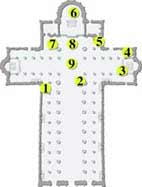The Duomo (Cathedral)
 Masterpiece of medieval architecture and almost a ”manifesto” for the purest Pisan-romanesque style, the Cathedral dedicated to the Assumption of the Virgin Mary is a monument to the splendour and wealth of the ancient Pisan Republic. It was built when the power of Pisa was at its heighest point as a temple of the Christendom dedicated to Mary, the town protectress.
Masterpiece of medieval architecture and almost a ”manifesto” for the purest Pisan-romanesque style, the Cathedral dedicated to the Assumption of the Virgin Mary is a monument to the splendour and wealth of the ancient Pisan Republic. It was built when the power of Pisa was at its heighest point as a temple of the Christendom dedicated to Mary, the town protectress.
The latin-cross shaped Cathedral a large structure of marble, calcar and stone is more than 100 meters long with a large ovoidal dome. The different styles of the impressive facade are beautifully blended to create a unity of unsurpassed harmony.
The three wide portals are surmounted by seven blind arches; higher up there is a succession of four small loggias with slender coloums and elegant statues. Among the latter a beautiful Madonna by Andrea Pisano.
The lateral walls and the apses are decorated with blind arches and black and white bands: the big dome is surrounded by an elegant gothic loggia.
Of special interest is the Porta di San Ranieri in the right transept. Its 24 bronze panels are the work of Bonanno Pisano (1180).
The interior of the Cathedral is solem and its atmosphere is reminiscent of an oriental mosque. There are five aisles (three in the transept) and two elegant women-galleries overlooking the central nave. The colums which support round arches come from different places and belong to different times; the wooden lacunar ceiling has replaced the previous one which was destroyed by fire in 1595. The great arch leading to the main altar under the great frescoed dome is supported by four big pillars.
The spectacular XIII century Pulpit by Giovanni Pisano in the middle of the Cathedral, was reassembled in 1926. Its beatiful octagonal structure, with sculpures and reliefs, is an outstanding example of the transition period of European art from the romanesque style to the dramatic gothic forms.

- Above the third lateral altar in the right hand side, Madonna delle Grazie, painting by Andrea del Sarto and Antonio Sogliani.
- Hanging from the ceiling in the central nave is the celebrated Galileo’s Lamp whose oscillations suggested to him the law of the pendulum.
- At the end of the right transept, Saint Ranieri’s chappel. An urn contains the bones of the Saint who is Pisa’s Patron.
- Close to the chappel there is the beatiful Tomb of the Emperor Henry VII made in the 1313 by Tino da Camaino.
- In the small aisle on the right hand side of the main altar, painting of The Last Supper by G.B. Tempesti.
- In the apse a remarkable mosaic representing Christ, The Holy Virgin and Saint John the Baptist: the latter is the work of Cimabue.
- In the small nave to the left of the main altar there is a metal icon, the so called Madonna sotto gli organi:
- In the Presbiterium, painting by Andrea del Sarto representing various Saints.
- The fresco in the dome painted in 1631 by Orazio and Girolamo Riminaldi represents The Assumption of the Virgin Mary.
